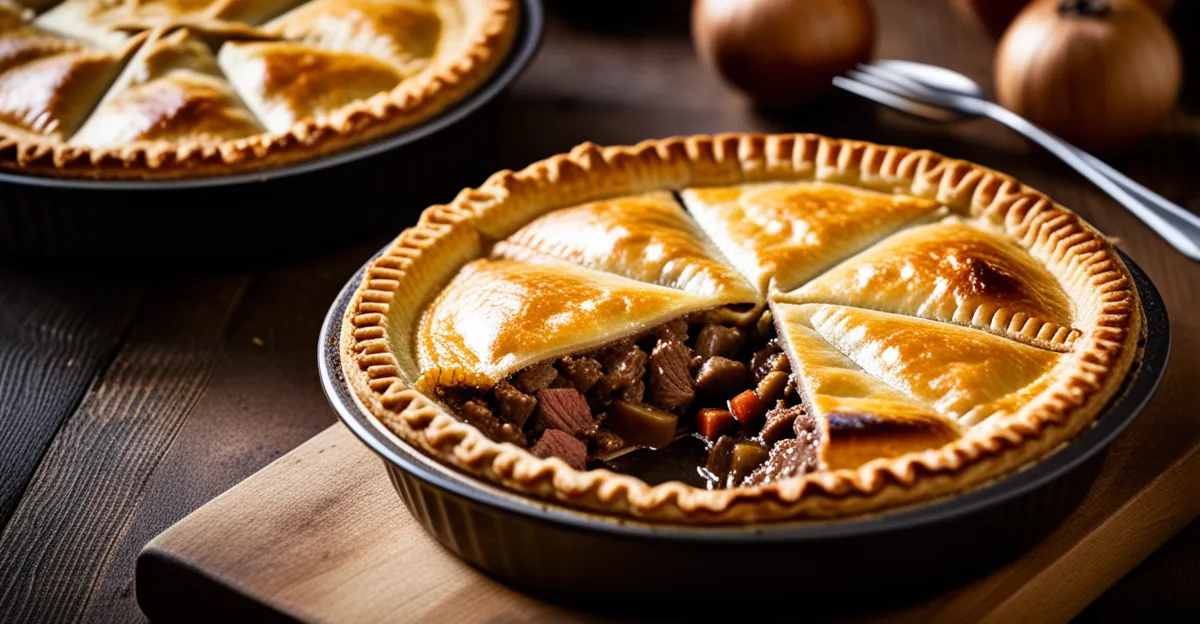Essential Ingredients and Preparation Steps
When making a classic steak and kidney pie, the steak and kidney pie ingredients must be selected carefully for both flavour and texture. The primary components include diced beef steak, traditionally chuck or braising steak for tenderness, and fresh kidney, often lamb or beef kidney. The ingredient list should also cover onions, flour for thickening, beef stock, and seasoning such as salt and pepper.
Preparing the steak and kidney correctly is crucial. Start by trimming excess fat and sinew from the steak to ensure it cooks evenly and remains tender. For the kidney preparation, rinse the kidney under cold water to remove any strong odors, then trim away the white core and fat. Cutting the kidney into small, uniform pieces helps achieve consistent cooking and texture.
Have you seen this : How do you create a savory toad in the hole?
Equipping yourself with a sharp knife and a sturdy chopping board will make the trimming and dicing process more efficient. Additionally, having a heavy-based saucepan or Dutch oven is recommended for browning the meat before simmering.
By focusing on careful selection and preparation of your steak and kidney pie ingredients, you lay a strong foundation for a tender, flavourful pie filling. This preparation stage directly influences the satisfaction of the final dish.
Additional reading : How can you master the art of a traditional sticky toffee pudding?
Cooking Techniques for Rich Flavour
Achieving a rich flavour in your steak and kidney pie starts with the browning of the meat. Browning both the steak and kidney is essential; it creates a deep, caramelised crust through the Maillard reaction, which significantly enhances the overall taste of the pie filling. To brown the meat effectively, use a heavy-based saucepan or Dutch oven over medium-high heat. Ensure the meat is dry by patting it with paper towels before adding it to the hot pan. Avoid overcrowding the pan, as this can cause the meat to steam rather than brown. Brown the steak pieces first to develop a robust flavour, then remove and set aside before browning the kidney, which requires less cooking time.
Once both the steak and kidney are browned, gently sauté onions and other aromatics in the same pan to absorb the meat’s flavours. This builds a fragrant base for the filling. Next, sprinkle flour over the mixture to act as a thickening agent for the pie filling. Gradually add beef stock while stirring continuously to create a silky, thickened sauce. Season carefully with salt, pepper, and optional herbs or Worcestershire sauce for added depth.
Simmering is the next critical step. Combine the browned meat and sauce, then cook gently at a low temperature for at least one to two hours. Slow simmering breaks down connective tissue in the meat, tenderising both the steak and kidney while allowing flavours to meld. Stir occasionally, ensuring the filling thickens without sticking to the pan. This pie filling preparation method ensures a savoury, luscious texture that defines a great steak and kidney pie.
Crafting the Perfect Pastry
Creating the ideal pastry for steak and kidney pie is pivotal to complementing the rich filling without overpowering it. Home cooks often debate between using homemade pastry or ready-made options. Homemade pastry, made from scratch with flour, fat (such as butter or lard), and cold water, offers superior flavour and flaky texture. It allows greater control over thickness and elasticity, ensuring it crisps evenly and supports the hearty filling.
When preparing pastry, consider these pastry tips for success. Roll out the dough evenly on a lightly floured surface to about 3-5mm thickness, avoiding overstretching which could cause shrinkage during baking. Fit the pastry gently into the pie dish, pressing lightly into corners to prevent air pockets. Trimming the excess edges neatly helps avoid burning, while leaving enough to create a good seal with the lid or top crust.
Preventing a soggy bottom is a key challenge. To tackle this, briefly blind-bake the pastry base before adding the filling. This step sets the pastry and creates a barrier against moisture from the steak and kidney pie ingredients. Another technique is to brush the raw pastry with beaten egg or a thin layer of mustard to repel liquid. When the pie is assembled, glaze the top pastry generously to achieve a golden, crisp crust once baked.
Understanding these nuances in pastry for steak and kidney pie elevates the final dish by balancing textures: a buttery, crunchy exterior encasing a tender, flavourful filling. Careful attention during rolling, shaping, and baking ultimately delivers a satisfying pie experience every time.
Assembly and Baking Guidelines
Careful assembling of steak and kidney pie is vital to preserve the filling’s moisture and ensure an even bake. Begin by spooning the cooled pie filling evenly into the prepared pastry-lined pie dish, leaving some space at the top for the pastry lid. To achieve a perfect seal, gently brush the edges of the base pastry with cold water or beaten egg before placing the pastry lid on top. Press the edges firmly together and crimp using a fork or your fingers to prevent leaks during baking.
For pie baking temperature, preheat the oven to around 200°C (390°F). This high initial temperature helps set the pastry quickly, forming a crisp, golden crust. Bake the pie for 20 minutes at this temperature before reducing the heat to 180°C (350°F) to allow the filling to cook thoroughly without burning the pastry. The total bake time usually ranges between 40 to 50 minutes, depending on your oven and pie size.
To check doneness, observe the pastry’s colour and texture: a rich golden-brown shade with a firm, flaky crust indicates readiness. Additionally, lightly tap the pie; it should sound crisp and firm. If the crust browns too rapidly but the filling feels undercooked, cover the top loosely with foil and continue baking to avoid burning.
These baking instructions ensure your steak and kidney pie presents a crunchy top and fully cooked, savoury filling — hallmarks of a well-executed dish. Proper sealing, temperature control, and baking duration come together to make a satisfying, professional-quality pie.
Serving Suggestions and Variations
When serving steak and kidney pie, pairing it with complementary side dishes enhances the overall dining experience. Traditional accompaniments include creamy mashed potatoes, buttery peas, or roasted root vegetables. These sides balance the richness of the pie filling by adding contrasting textures and fresh flavours. For a lighter option, consider a crisp green salad dressed with a tangy vinaigrette to cut through the pie’s heartiness.
Exploring pie variations allows home cooks to tailor the classic recipe to personal tastes. Adding mushrooms introduces an earthy depth, while substituting or combining ale in the gravy enriches the sauce with maltiness. Some recipes incorporate herbs like thyme or rosemary to bring aromatic complexity. For those who prefer a milder flavour, chicken or pork kidneys can replace beef or lamb without sacrificing texture.
Proper storage and reheating are crucial for preserving the quality of a leftover steak and kidney pie. Cool the pie thoroughly before refrigerating to prevent sogginess. When reheating, cover the pie loosely with foil and warm it in the oven at a moderate temperature—around 160°C (320°F)—until heated through. This method helps maintain the crispness of the pastry while ensuring the filling remains moist and flavourful.
By considering these serving steak and kidney pie suggestions and pie variations, you can enjoy this classic dish in diverse, satisfying ways that suit different occasions and palate preferences.





